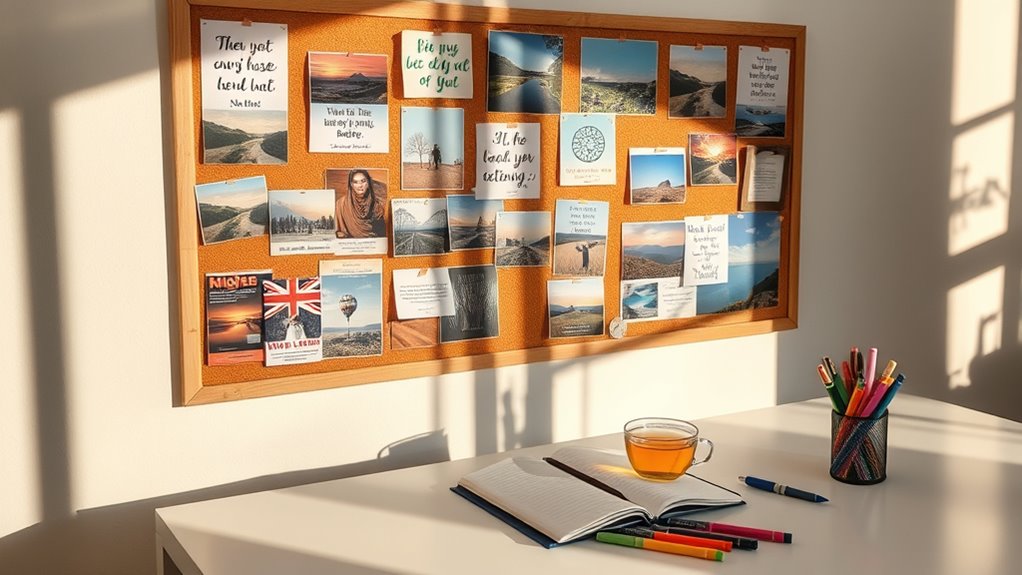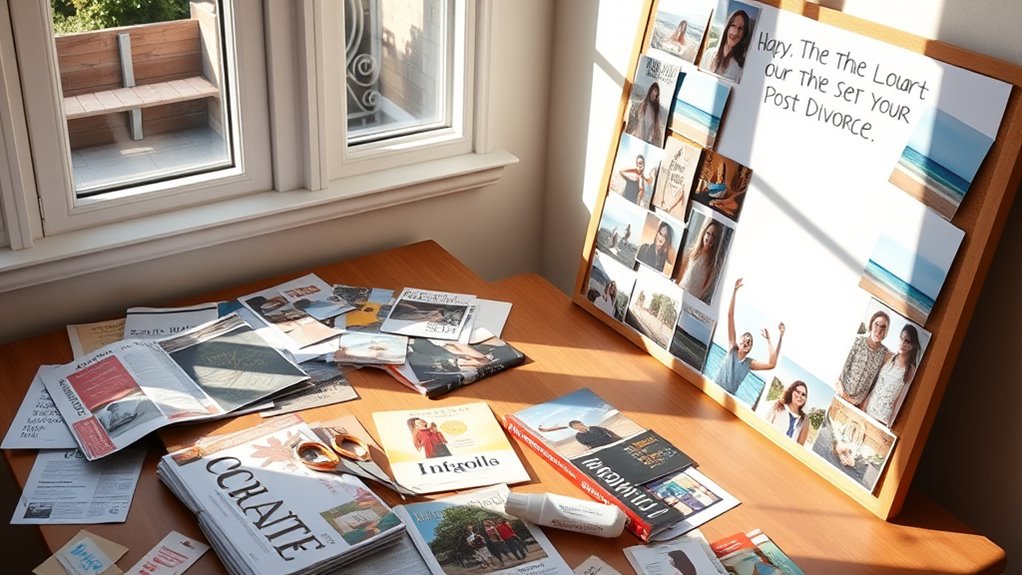Creating a vision board after divorce helps you focus on your future goals and rebuild confidence. You can include inspiring quotes, images of new dreams, and reminders for self-care—all tailored to your personal aspirations. Start by clarifying what you want to achieve, gather meaningful visuals, and arrange them thoughtfully. Regularly updating your board keeps you motivated and aligned with your evolving goals. Keep exploring to discover how this powerful tool can guide your next chapter.
Key Takeaways
- Begin with honest journaling to identify your new life goals and aspirations.
- Collect inspiring images, quotes, and affirmations that resonate with your future vision.
- Arrange your visuals thoughtfully on a board to create a clear, motivating representation of your goals.
- Incorporate monthly planners and self-care reminders to organize progress and nurture emotional well-being.
- Regularly review and update your vision board to stay focused, motivated, and aligned with your evolving post-divorce aspirations.

Exploring life after divorce can feel overwhelming, but creating a vision board offers a powerful way to focus your energy on your future. It helps you maintain a positive and focused mindset during this transitional period, giving you a visual reminder of the life you’re working toward. By envisioning your desired future, you can clarify your intentions and set meaningful goals that support your emotional healing and personal growth. A vision board isn’t just about images; it’s a tool that encourages self-discovery, empowerment, and the establishment of boundaries that protect your well-being as you rebuild your life.
When you craft a post-divorce vision board, include inspiring quotes that resonate with overcoming challenges. These words can serve as daily motivation, reminding you of your strength and resilience. Add visual elements that represent your new life goals—whether it’s advancing your career, traveling to new places, or pursuing education. Incorporate monthly planner templates to break down long-term goals into manageable, actionable steps, guaranteeing you stay motivated and organized. Gratitude and self-care reminders are essential; they help you nurture your mental and emotional health while you navigate this change. Personal affirmations and images that reflect your authentic self will boost your confidence and inspire you to stay aligned with what truly matters to you.
Creating an effective vision board begins with honest journaling or listing your aspirations for this new chapter. Think about what you want to achieve, how you want to feel, and the kind of life you’d love to create. Gather images and words from magazines or printed materials that symbolize these goals. Arrange your selected items thoughtfully on a board, visualizing your future vividly and clearly. Use your board regularly—review it often to stay focused and make adjustments as your desires become more defined. Incorporating practices like meditation and gratitude can amplify the impact of your vision board, helping you stay centered and motivated. Studies have shown that visualization techniques can significantly reduce stress and increase motivation, making your goals more attainable. Developing a clear mental picture of your goals can also enhance your emotional resilience and foster a more positive outlook during this transformative period.
Start with honest journaling to clarify your goals and visualize your future clearly.
The psychological benefits of visualization are profound. Seeing your goals visually strengthens your belief that they’re achievable, even during emotionally turbulent times. It offers a sense of control and direction, transforming abstract hopes into tangible cues. As you focus on your vision board, you’ll naturally prioritize your needs and values, promoting better self-alignment. Tracking your progress visually keeps your motivation high, reminding you of how far you’ve come and what’s still ahead. Ultimately, your vision board becomes a dynamic tool for reclaiming your identity, establishing healthy habits, pursuing passions, building new relationships, and securing financial independence. Regularly reviewing and updating it ensures your goals evolve with you, making it an ongoing source of inspiration and clarity as you create your new life after divorce.
Frequently Asked Questions
How Soon Should I Create My Post-Divorce Vision Board?
You can create your post-divorce vision board whenever you feel emotionally ready and have had enough time to process your loss. It’s best not to rush; wait until you’re clear on your goals and intentions. When you’re feeling motivated and stable, gather your materials and start. Regularly updating your board as you grow guarantees it remains a meaningful guide on your healing journey.
Can I Include Negative Emotions in My Vision Board?
You shouldn’t include negative emotions in your vision board. Focus on images and affirmations that evoke positivity, hope, and resilience. Visual cues of healing and future goals help reprogram your subconscious for growth and motivation. Including negative feelings might reinforce them, making it harder to move forward. Keep your vision board simple, inspiring, and centered on what you want to achieve and the positive emotional states you aim to cultivate.
Is Digital or Physical Vision Board More Effective?
You’ll find both digital and physical vision boards effective, but it depends on your preferences and lifestyle. Digital boards are quick to update, easy to carry, and great for organized goals, while physical boards offer tactile engagement and constant visual reminders. Consider combining both to maximize benefits—use digital for flexibility and convenience, and physical for emotional connection and daily inspiration. Choose what aligns best with your habits and goals.
Should I Involve Others When Creating My Vision Board?
You should consider involving others if you seek emotional support, motivation, or diverse perspectives. Collaborating with trusted friends or family can boost your confidence and keep you accountable, especially during a challenging shift like divorce. However, if you prefer personal reflection or want to keep your goals private, creating your vision board solo guarantees it truly represents your authentic desires without external influence. Choose what best supports your healing journey.
How Often Should I Update My Post-Divorce Vision Board?
You should update your vision board every 3 to 6 months, unless life feels like it’s shifting rapidly. Think of it as tuning a radio—you want your goals to stay clear and relevant. During big changes, monthly updates can help keep you motivated, but avoid overdoing it. Regular tweaks help you stay aligned with your evolving dreams, making your journey post-divorce feel fresh and purposeful.
Conclusion
So, while you might think a vision board is just about picturing a new life, it’s actually about embracing the unexpected. Ironically, by focusing on your dreams, you might just discover that what you least expected—growth, happiness, or even love—are waiting right around the corner. After all, sometimes the best plans unfold when you let go of control and trust the journey. Here’s to creating a future you never saw coming.










